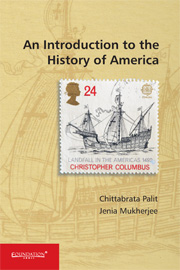Book contents
- Frontmatter
- Contents
- Preface
- Timeline of Events
- 1 An Early History: From Settlement to Colonization
- 2 The American War of Independence
- 3 The Formative Period: The Era of Solidarity and Expansion
- 4 ‘Two Americas’: Regional Differences and Sectional Conflicts
- 5 Agrarian and Industrial Revolutions
- 6 Resisting Voices
- 7 American Foreign Policy: Post-Monroe Doctrine to World War I
- 8 The Great Crisis and Its Recovery
- 9 The Rise of America: WWII and After
- 10 The Quest for Equality
- 11 American Environmentalism and Environmental History
- Epilogue: Perceiving American History Beyond the ‘Exceptionalist’ Framework
- Index
1 - An Early History: From Settlement to Colonization
Published online by Cambridge University Press: 05 April 2014
- Frontmatter
- Contents
- Preface
- Timeline of Events
- 1 An Early History: From Settlement to Colonization
- 2 The American War of Independence
- 3 The Formative Period: The Era of Solidarity and Expansion
- 4 ‘Two Americas’: Regional Differences and Sectional Conflicts
- 5 Agrarian and Industrial Revolutions
- 6 Resisting Voices
- 7 American Foreign Policy: Post-Monroe Doctrine to World War I
- 8 The Great Crisis and Its Recovery
- 9 The Rise of America: WWII and After
- 10 The Quest for Equality
- 11 American Environmentalism and Environmental History
- Epilogue: Perceiving American History Beyond the ‘Exceptionalist’ Framework
- Index
Summary
A prelude to the American Revolution, the chapter begins with a geological account of migration, spread and settlement of human population in the American continents in the Holocene period. The pre-colonial history of America is the history of efflorescence of several Native American cultures which is evident from archaeological excavations. The first section of the chapter sheds light on the economic, social, and cultural life of the Native Americans along with internal strife and conflicts between the native inhabitants and the Europeans. The discovery of America much before Amerigo Vespucci by the Norse (Vikings) is attested in the next section. The pre-Columbian expeditions were followed by Spanish, Portuguese, French, and later Dutch and English explorations. By explaining the reasons behind colonization in terms of god, glory, and gold, the final section provides detailed accounts of the exploration events and its impact on the indigenous communities and ecosystems of the continents.
a. Early Signs of Life and Native American Cultures
About 60,000–25,000 years ago, the Bering land bridge that joined Siberia to Alaska was created because of falling sea levels. Migrations of humans from Eurasia to the Americas took place through this bridge till around 12,000 years ago. Linguistic and genetic data attest the fact that the early Paleo-Americans soon spread throughout the Americas and diversified into many hundreds of culturally distinct nations and tribes. The North American climate stabilized by 8000 BCE, followed by widespread migration, cultivation of crops, and subsequently, a dramatic population spurt in the North and South Americas.
- Type
- Chapter
- Information
- An Introduction to the History of America , pp. 1 - 22Publisher: Foundation BooksPrint publication year: 2014

